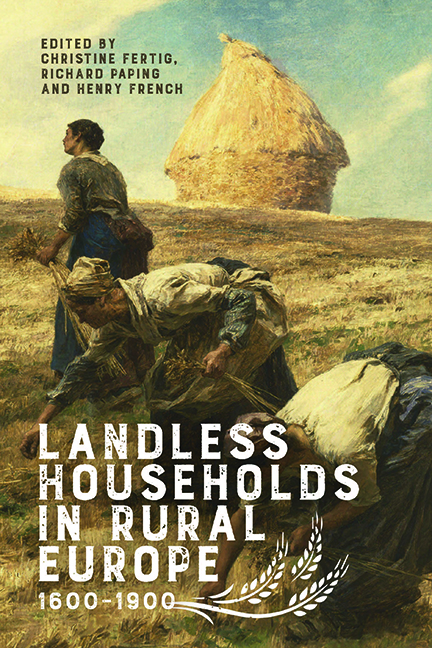Book contents
- Frontmatter
- Contents
- List of Illustrations
- Notes on Contributors
- Preface
- Introduction
- 1 The Treballadors of Girona: Evidence of the Emergence of Wage Labour in Early Modern Catalonia in the Sixteenth and Seventeenth Centuries
- 2 The Squatter Economy of the English Countryside: Building New Landless Communities in England, c. 1600–1900
- 3 The Rise of Landless Households in the Dutch Countryside, c. 1600–1900
- 4 ‘Gaining Ground’ in Flanders after the 1840s: Access to Land and the Coping Mechanisms of Landless and Semi-Landless Households, c. 1850–1900
- 5 Strategies of Survival, Landlessness and Forest Settlement in Flanders: The Forest of Houthulst in a Changing Landscape of Survival (c. 1500–1900)
- 6 Landless and Pauper Households in England, c. 1760–1835: A Comparison of Two Southern English Rural Communities
- 7 Landless Rural Households in France, 1852–1910
- 8 Survival in a Hostile Agrarian Regime: Landless and Semi-Landless Households in Seventeenth-Century Sweden and Finland
- 9 Farming Craftsmen? Access to Land and the Socio-Economic Position of Rural Artisans in Early Modern Finland
- 10 Landlessness and Marriage Restrictions: Tyrol and Vorarlberg in the Eighteenth and Nineteenth Centuries
- 11 Cottages, Barns and Bake Houses: Landless Rural Households in North-Western Germany in the Eighteenth Century
- Bibliography
- Index
- Boydell Studies in Rural History
8 - Survival in a Hostile Agrarian Regime: Landless and Semi-Landless Households in Seventeenth-Century Sweden and Finland
Published online by Cambridge University Press: 08 October 2022
- Frontmatter
- Contents
- List of Illustrations
- Notes on Contributors
- Preface
- Introduction
- 1 The Treballadors of Girona: Evidence of the Emergence of Wage Labour in Early Modern Catalonia in the Sixteenth and Seventeenth Centuries
- 2 The Squatter Economy of the English Countryside: Building New Landless Communities in England, c. 1600–1900
- 3 The Rise of Landless Households in the Dutch Countryside, c. 1600–1900
- 4 ‘Gaining Ground’ in Flanders after the 1840s: Access to Land and the Coping Mechanisms of Landless and Semi-Landless Households, c. 1850–1900
- 5 Strategies of Survival, Landlessness and Forest Settlement in Flanders: The Forest of Houthulst in a Changing Landscape of Survival (c. 1500–1900)
- 6 Landless and Pauper Households in England, c. 1760–1835: A Comparison of Two Southern English Rural Communities
- 7 Landless Rural Households in France, 1852–1910
- 8 Survival in a Hostile Agrarian Regime: Landless and Semi-Landless Households in Seventeenth-Century Sweden and Finland
- 9 Farming Craftsmen? Access to Land and the Socio-Economic Position of Rural Artisans in Early Modern Finland
- 10 Landlessness and Marriage Restrictions: Tyrol and Vorarlberg in the Eighteenth and Nineteenth Centuries
- 11 Cottages, Barns and Bake Houses: Landless Rural Households in North-Western Germany in the Eighteenth Century
- Bibliography
- Index
- Boydell Studies in Rural History
Summary
This chapter discusses the existence and conditions of non-landed households in rural Sweden (including Finland) in the seventeenth century. This heterogeneous group encompassed both landless and semi-landless people, from relatively affluent, independent artisan families to destitute beggars. Some had access to land, albeit little, and should be referred to as semi-landless or land-poor. In the administrative thinking of the time, however, they were all part of the non-landed1 population, that is, those who did not contribute to the state economy by paying taxes based on their holdings. What united them was that they had no or very little control over land.
As we will show below, the story of the Swedish non-landed population in the seventeenth century is one full of contradictions. On the one hand, hostile attitudes to households and individuals without land were typical and widespread in this regime. On the other hand, the economy depended on their labour. Repeated ordinances declared that lodgers should not be tolerated, that cottages and crofts were to be torn down and that temporary labour was forbidden; yet lodgers, cottages, crofts and casual labour abounded in rural Sweden and Finland. We investigate how this was possible, and how – given the many restrictions and official attitudes – households with little or no land were able to survive. Thus, the chapter contributes to the discussion of ‘pauper agency’ and what people on the margins did to survive. In general, the historiography of the European poor has witnessed a shift from attention to structures, such as the extent of poverty and the institutions of poor relief, to an interest in agency and coping strategies.
We first introduce the agrarian system of early modern Sweden and the non-landed groups within it, then describe the hostile environment in which they had to navigate and the laws and underlying interests that created it. We show that the numbers of landless and semi-landless households in seventeenth-century Sweden were substantial, despite regulations. Finally, we discuss the opportunities that nonetheless were at hand and how non-landed households exploited these.
- Type
- Chapter
- Information
- Landless Households in Rural Europe, 1600-1900 , pp. 196 - 219Publisher: Boydell & BrewerPrint publication year: 2022



